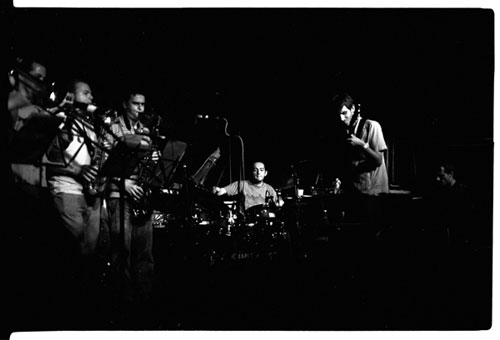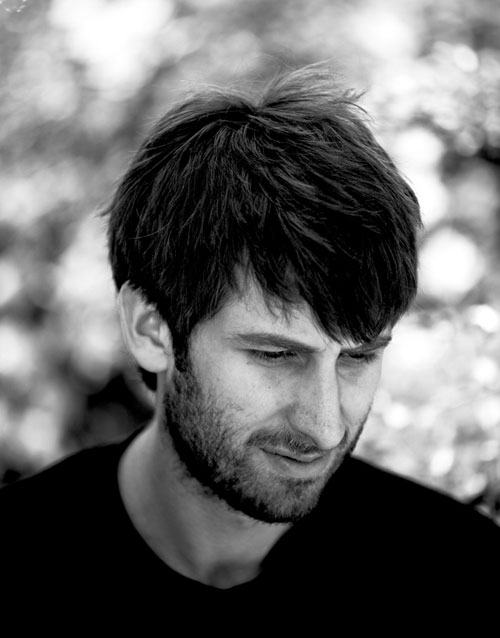Ben Lamdin’s Nostalgia 77 project has produced seven LPs in just four years, each one introducing new elements to his self-proclaimed ‘jazz jihad’.

After releasing a couple of hip hop 45s on Tru Thoughts, Nostalgia 77’s sound started moving towards jazz with modest experiments in sampling live instruments. First, Lamdin hooked up with trumpet player Tom Allan. Allan then introduced him to bass player Riaan Vosloo, and so on it went, until he found himself plugged into an extended network of jazz instrumentalists.
The resulting albums, 2004’s Songs for My Funeral and 2005’s The Garden, were put together on Lamdin’s computer. While these albums established a jazzier sound and mood than Lamdin’s earlier hip hop 45s, the production approach was still rooted in his formative hip hop aesthetic.
As Nostalgia 77 built a following through these two albums and Lamdin’s DJ appearances, he decided to try performing the material from his album live. This experiment had a profound impact on Lamdin and his sense of Nostalgia 77’s possibilities. Gathering a full eight-piece band, he described the experience of hearing his songs performed by a live band as revelatory – “I thought, ‘wow, this is what it can sound like?'”. From that point, he had no doubt that he wanted to record the band as a group.
The first release from the newly-formed Nostalgia 77 Octet was Sevens and Eights (2006), a recording of a live performance at the Jazz Cafe in London. The live versions of songs from The Garden are illustrative of the kinds of transformations which so excited Lamdin when he put the band together. Certainly, some key dimensions of the originals are lost, but the band’s interpretations bring out other dimensions – in particular, they achieve moments of emotional intensity that are the product of live interaction between the musicians.
The original version of “Green Blades of Grass”, for instance, is built on a rugged and stilted groove, with drums, bass and guitar snapping away in a seriously bent jazz beat that gives a nod to J Dilla’s trademark production aesthetic. In performance, the band sound a lot less ‘amateur’, if you like – where the sample-based version had been deliberately and deliciously out, the live rhythm section is far more in sync with each other. But harmonically, the horn melodies in the live interpretation are more sophisticated, and the rhythm section loosens up underneath the solos. In particular, the track achieves a new dramatic intensity thanks to Ross Stanley’s piano excursions, which push the band to take the track to new places. The band’s performance of “The Hunger”, by contrast, adds rhythmic complexity to the studio original. The overlapping horn melodies of the studio version are now underpinned by much freer drumming, which lend the track a kind of New Orleans funeral march feel. Then the initial restraint of the horns gives way to a furious and unexpected synth solo mid way through the track.
In his liner notes to Sevens and Eights, Tru Thoughts Label Manager Rob Luis sought to position the performance in this way: “In a musical culture still dominated by the sampler and the DJ, this group unapologetically insists on the continued relevance of musicianship and live performance, and proves that good players can perform for the club kids and old school jazz heads alike, without leaving either short-changed….Their music looks to the future with the same conviction that it refuses to throw away the past. This is 21st Century Jazz.”
Of course, it is the job of liner notes to be effusive. But Luis has a point in alluding to a tension that Lamdin and the musicians involved in his projects have had to negotiate.
In exploring this tension between the worlds of the ‘club kids’ and ‘old school jazz heads’, and the possibility for its negotiation, I asked Lamdin whether he and his musicians shared an outlook and approach to making music. He told me that there were some important differences: “They’re great musicians, and they’ve devoted a long time to learning their instrument, so they tend to value and focus on virtuosity. But for me, I’m more interested in the sounds, the atmosphere a track evokes.”
To some extent, this difference reflects the fact Lamdin and his musicians are likely to look to different parts of the jazz cannon for inspiration. The jazz artists whose work has been recovered through hip hop and sampling are not necessarily those artists whose musicianship tends to make its way onto the curricula of jazz students. Nonetheless, they did establish some common ground: “There are some artists who I love who have also forged different styles of jazz which the musicians continue to admire – John Coltrane, for instance, or Duke Ellington. Or Mingus – everyone seems to agree on how fantastic his music is.”
But even here, these same artists might be valued for different reasons. Where a jazz musician might appreciate them for their improvisational and compositional approach, Lamdin also hears a production aesthetic which influences his approach. “There’s a kind of ‘amateurishness’ to some of those recordings – I don’t mean in terms of the playing, just that there’s a kind of roughness that I really like.”
What’s interesting here is that while the skills and virtuosity of a group of jazz musicians have become necessary ingredients for Lamdin to create the quality of music that he is reaching for, he is not necessarily aiming to produce a ‘jazz album’ which is a showcase for these skills and virtuosity. The atmospheres and moods, the sounds that the instruments and band produce, the emotional qualities of the songs and their fit with a hip hop-influenced appreciation of certain styles and periods of jazz, are his priorities. This doesn’t preclude virtuosity, but it doesn’t prioritise it either.
Perhaps where Lamdin’s approach does engage more directly with jazz traditions relates to the role of the producer. While he plays a bit of guitar and piano and takes part in Octet performances and in the studio, Lamdin is quick to tell me that he’s not really a musician in the sense that his players are. Rather, he sees himself as a producer, trying to make good records by bringing together the right musical and technical elements. As such, he modestly located his efforts alongside the jazz producers of the 60s and 70s who inspired him, not just the artists – as he points out, “in that period, there was a strong role for the producer in jazz, with certain producers recording and producing work by a lot of different artists.”

Lamdin’s production skills have had to keep expanding to keep pace with his vision for the Nostalgia 77 project. After the success of the initial live performances, he wanted to record the band in a studio setting. Through the girlfriend of a band member, the Octet found a cottage in Wales with a barn, which was converted into a recording studio for a week-long session to write and record new songs as a band. This week produced two Nostalgia 77 Octet releases – the limited vinyl-only LP Impossible Equation, and Borderlands (both 2006). Band members contributed compositions to these LPs, while Lamdin was forced to learn a thing or two about how to record and produce a full band. In keeping with the production aesthetic he had established in early recordings, he kept things low-tech. Drawing inspiration from his favourite jazz records, he rejected close microphones and strict track separation in favour of techniques which kept the room in the recording: “I’ve seen photos even of Frank Sinatra in the studio, where there was just one microphone at the front of the room, with Frank standing close and band set up behind him. We didn’t do that exactly, but I’m more into that way of doing things.”
In 2007, with the release of the Nostalgia 77 album Everything Under the Sun, Lamdin shifted back to a process of studio assemblage. Different tracks featured different combinations of musicians, and vocalists Lizzy Parks (whose first solo album Lamdin has just produced for Tru Thoughts) and Beth Rowley were added to the mix. The vocal songs add a further layer of accessibility to tracks like “Wild Flower” and “Quiet Dawn”. Vocals were also included in some tracks on the N77 Octet’s latest release, Weapons of Jazz Destruction (2007).
Maintaining both the Nostalgia 77 and Octet vehicles for his productions seems to allow Lamdin the best of both worlds, such that he’s not forced to choose between sampling and band productions. Along with bass player Riaan Vosloo, he has also established the Impossible Ark label, which has so far released albums by jazz instrumentalists and fellow travellers like Australian saxophonist Max Grunhard.
Lamdin’s success with Nostalgia 77 says something about the fractured legacies and futures of ‘jazz’. With the full support and distribution networks of the Tru Thoughts label, Nostalgia 77’s albums are reaching musical scenes where jazz circulates as an ingredient or influence. In these scenes, the albums are often identified and appreciated as ‘jazz’ – Weapons of Jazz Destruction, for instance, was voted “jazz album of year” in BBC1 DJ Gilles Peterson’s 2007 audience poll. But whether or not these albums are also reaching a more conventional jazz audience is far from certain. Luis’ optimism that the band is reaching both the ‘club kids’ and the ‘jazz heads’ notwithstanding, the extent to which the different aesthetics and distribution networks of the club and jazz scenes can be bridged remains an open question. Certainly, it would certainly be interesting to talk more to Lamdin’s musicians about how they fit their work with Nostalgia 77 into their efforts to build careers as jazz instrumentalists. Even as jazz musicians themselves are crossing different musical scenes through the efforts of producers like Lamdin, are they bringing jazz audiences with them?
Ultimately, though, the ‘jazz’ question is not uppermost in Lamdin’s own thinking. His main concern, he says, is to produce good music – and Lamdin’s optimistic outlook that good music will find its own audience seems to have been confirmed as Nostalgia 77’s following has grown. As we wrapped up our conversation, Lamdin wanted me to know how genuinely thrilled and grateful he was that his music has found such a supportive home and enthusiastic audience.
Nostalgia 77’s One-offs, Remixes and B-sides is available from Tru Thoughts/Creative Vibes.



